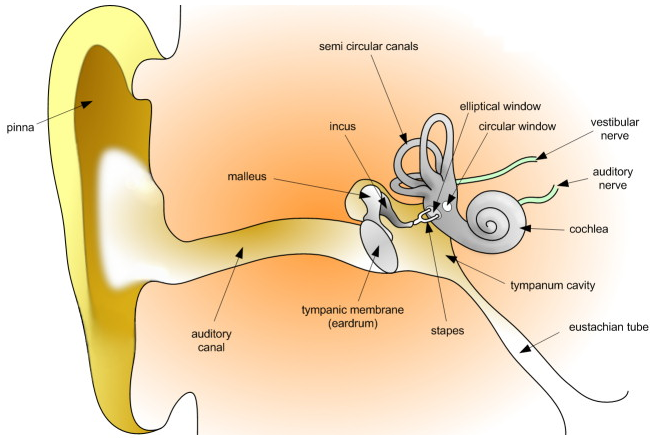Level 1
What is sound?
Sound is something that can be heard audibly, such as voices, music, nature, machinery and so on. Sounds enable us to perceive our physical environment, especially to communicate (speaking and listening), to enjoy (music), and to alert us (danger).
What are your favorite sounds?
What kinds of sounds might alert you?
Sounds can also be felt through the human body. Loud and low-frequency sounds can be felt as vibrations.
What kinds of sounds can you feel?
How does the human ear work?

The human ear has three sections: the outer ear, the middle ear, and the inner ear. The shape of the outer ear (pinna) acts to redirect sound through the auditory canal to your eardrum. The eardrum is a delicate membrane that vibrates to sound waves.
These vibrations are passed in order to three tiny bones in the middle ear: the hammer (malleus), the anvil (incus) and the stirrup (stapes). At the inner ear, the stirrup touches a liquid filled sack and the vibrations travel the cochlea. Inside the cochlea, hundreds of special hair cells attached to nerve fibers transmit information to the brain through the auditory nerve.
Each part of our ears is tiny and highly sensitive. Exposure to loud or prolonged noise damages the hair cells and the transmission of sound is permanently altered.
In the course of a lifetime, you will lose a percentage of your hearing because of noise pollution.
What is noise pollution?
Noise pollution is unwanted human-created sound that has the effect of being annoying, distracting, painful, or physically harmful. The word noise comes from the Latin word nausea meaning seasickness.
Environmental sound is not noise pollution. For example, the sound of a thunderstorm is not noise pollution.
Can you describe at least three sources of noise pollution?
What is a decibel?
A decibel (denoted as dB) is a measurement of sound. The "A" standard is a filter used to approximate human hearing; the "C" standard is commonly used to measure low frequency sound that can be felt.
Decibels are measured logarithmically, that means that the perceived loudness doubles with every 10 (dB) increase.
Here is a decibel scale showing different kinds of sounds and how it can affect you.
| Type of Sound | Decibel dB(a)/(c) | Hearing Effect |
|---|---|---|
| Jet Takeoff | 150 | Permanent Hearing Loss |
| Boom Car | 140 | |
| Train Horn | 130 | |
| Car Alarm | 120 | Pain Threshold |
| Leaf Blower | 100 | Risk of Hearing Loss |
| Motorcycle | 90 | |
| Traffic Noise | 80 | Loud |
| Vacuum Cleaner | 70 | Intrusive |
| Classroom Activities | 60 | Comfortable |
| Conversation | 50 | |
| Whisper | 30 | Very Quiet |
| Breathing | 20 | Barely Audible |
How can you protect your hearing?
The simplest way to protect your hearing when you hear loud noises is to cover your ears with your fingers or the palms of your hand.
When using a portable music player, a television, or stereo, adjust the volume so that it does not prevent you from hearing other sounds in your surroundings. If you feel any kind of discomfort or ringing in your ear, it is definitely too loud.
You can also protect the hearing of others by being considerate, by not creating excessive noise.
What other ways can you protect your hearing?





